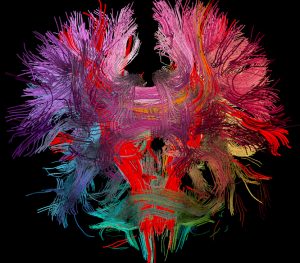
A new study has discovered that certain molecular structures found in biological cells are capable of maintaining a peculiar quantum state, despite the common view that biological systems like the human body are hostile to fragile processes like these. This discovery suggests that the body may have not only a high-speed fiber optic system used to transmit information, but also a quantum-based defense against neuro-degenerative diseases such as Alzheimer’s—not to mention providing the basis for quantum consciousness.
Tryptophan, an amino acid typically associated with the production of the mood-leveling neurotransmitter serotonin, is capable of a process known as fluorescence: much like the same process that happens in a fluorescent light, this is a quantum process where the molecule can absorb a photon at a certain frequency, and in turn re-emit that energy as another photon at a different frequency altogether.
Although tryptophan’s fluorescent properties have been known for quite some time, it wasn’t until researchers with Howard University’s Quantum Biology Laboratory studied the molecule’s quantum properties when arranged into structures called ‘microtubules’. Once arranged in these configurations the molecules displayed another quantum state called ‘superradiance’, where the energy released is both stronger than what would be emitted by a solitary molecule, and also in a pulse of a much shorter duration.
Interestingly, this superradiant effect is enhanced as the complexity of the arrangement of the microtubule structures is increased: when absorbing a single UV-B photon, a tryptophan molecule fluoresces that energy back as a lower frequency, typically as a lower-energy UV-A photon; when the tryptophan molecules are arranged in a microtubule structure their collective output is greater than what they would have emitted individually.
Building on this effect, multiple tryptophan-based microtubules arranged in clusters of nine groups of three bundles—a configuration similar to the centrioles found in most animal cells—causes a further increase in the superradiance effect. Re-arranging the microtubules into a bundle of 19 strands, a structure found in the nerve fibers that branch out from mammalian neurons, increases that quantum yield yet again.
The researchers suspect that this superradiance may act as a quantum-based defense against damaging ultraviolet radiation: the wavelength that excites tryptophan is in the UV-B range, a frequency in the electromagnetic spectrum that carries enough energy to ionize the atoms in our DNA, causing genetic damage; conversely, the re-emitted light is at a lower frequency, typically in the UV-A range, a wavelength that doesn’t exhibit cell-damaging levels of energy.
It’s this frequency-dampening effect that may help protect our neurons from damage that could lead to degenerative conditions such as Alzheimer’s, although more research would be required to determine whether or not this is the case. Additionally, their capacity for superradiance could explain how individual nerves transmit information internally: the conventional understanding is that information is internally transmitted by ions, charged atoms that have to traverse a number of membranes to travel from one end of the neuron to the other. However, this process takes a number of milliseconds to unfold inside each cell, too long to account for the relative rapidity of our neurological processes.
Superradiance, on the other hand, occurs in a matter of picoseconds—billionths of a second, as opposed to the thousands of a second that it takes to transmit ions; literally, the tryptophan bundles found in neurons could act as a form of fiber optic cable, transmitting their information hundreds of millions of times faster than any chemical processes could be capable of.
“Such quantum optical networks are widespread, not only in neural systems but broadly throughout the web of life,” explained Michael Levin, director of the Tufts Center for Regenerative and Developmental Biology, who was not involved in the study. “The remarkable properties of this signaling and information-processing modality could be hugely relevant for evolutionary, physical, and computational biology.”
Being able to stabilize quantum states in ordinary environments could also have far-reaching consequences for quantum computers: currently, the qubits that make up these strange devices have to be housed in large, energy-hungry mechanisms that isolate the processor from outside radiation and refrigerate the device to temperatures near absolute zero. Despite these extreme measures, maintaining the states of the individual qubits is akin to herding cats; making qubits that are stable in an otherwise “noisy” everyday environment would be a major leap forward in the field of quantum computing.
Although the researchers did not address the idea, this quantum stability also dovetails with the idea of quantum consciousness put forward by physicist Roger Penrose and anesthesiologist Stuart Hameroff, in a theory referred to as ‘orchestrated objective reduction’ (‘Orch OR’). They propose that “consciousness arises from quantum vibrations in protein polymers called microtubules inside the brain’s neurons, vibrations which interfere, ‘collapse’ and resonate across scale, control neuronal firings, generate consciousness, and connect ultimately to ‘deeper order’ ripples in spacetime geometry,” according to Hameroff. “Consciousness is more like music than computation.”
Subscribers, to watch the subscriber version of the video, first log in then click on Dreamland Subscriber-Only Video Podcast link.